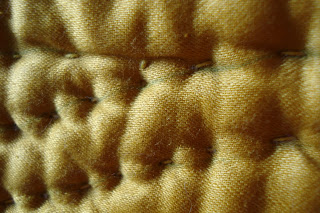
Here is another Welsh strippy quilt. The cotton fabrics are a plain coral pink and an art nouveau print in green and pink. The overall size is 84 x 76 inches. The back is an olive green colour, which has faded in some areas.
Welsh quilts, Durham quilts and the British tradition of bellringing.

 Here is a quilt that I consider one of my study pieces. It did not cost much, as the edges are very worn. Many people would trim off the edges and rebind, but I prefer to keep these quilts as I bought them. Bindings are not the norm on a Welsh quilt. This is a Welsh strippy - you can see that the strips are a bit wider than some of the north country quilts.
Here is a quilt that I consider one of my study pieces. It did not cost much, as the edges are very worn. Many people would trim off the edges and rebind, but I prefer to keep these quilts as I bought them. Bindings are not the norm on a Welsh quilt. This is a Welsh strippy - you can see that the strips are a bit wider than some of the north country quilts. The quilting pattern is an overall wineglass pattern, with some spirals to fill in any odd corners. It just goes to show, simple patterns can be so effective, you don't have to be complicated all the time....the quilter was working quickly and was drawing the pattern outlines with chalk on the frame as she was quilting from one side to the other.
The quilting pattern is an overall wineglass pattern, with some spirals to fill in any odd corners. It just goes to show, simple patterns can be so effective, you don't have to be complicated all the time....the quilter was working quickly and was drawing the pattern outlines with chalk on the frame as she was quilting from one side to the other.

 Here is a quilt which looks much better now than when I bought it!
Here is a quilt which looks much better now than when I bought it!



Here is a small "molita" - applique with embroidery, colourful and made for the tourist trade. Two hummingbirds with hibiscus flowers.





 Maria, Ruth, Ernest and Lynn Fuller - my Grandmother, Mother, Uncle and Grandfather. I'm guessing that this photo was taken before 1929.
Maria, Ruth, Ernest and Lynn Fuller - my Grandmother, Mother, Uncle and Grandfather. I'm guessing that this photo was taken before 1929. Here are two woven rugs that are special to me because they were made by my maternal grandmother, Maria Fuller (ne Dalke). After the 1929 stock market crash, the family had to move from Dearborn near Detroit back to the family farm at Enid, Oklahoma. Maria supported her family by raising chickens, canaries and fox terriers and also weaving rugs on a twelve heddle loom (I hope that is the correct term because I don't know very much about weaving on looms). And Grandad had to learn all about wheat farming!!
Here are two woven rugs that are special to me because they were made by my maternal grandmother, Maria Fuller (ne Dalke). After the 1929 stock market crash, the family had to move from Dearborn near Detroit back to the family farm at Enid, Oklahoma. Maria supported her family by raising chickens, canaries and fox terriers and also weaving rugs on a twelve heddle loom (I hope that is the correct term because I don't know very much about weaving on looms). And Grandad had to learn all about wheat farming!!
 Here are some carvings that I found around the doorway arch of a church in Norfolk ( I think it was the church at Barton Turf). The top one reminded me of the braids and twists we find on quilts - the bottom one just amused me. It also reminded me of the slate gravestones that we used to "rub" in some of the older graveyards in New Jersey, with the winged angel's heads and other interesting designs.
Here are some carvings that I found around the doorway arch of a church in Norfolk ( I think it was the church at Barton Turf). The top one reminded me of the braids and twists we find on quilts - the bottom one just amused me. It also reminded me of the slate gravestones that we used to "rub" in some of the older graveyards in New Jersey, with the winged angel's heads and other interesting designs.





 Here is a stamped "Durham" quilt that I believe to have been finished in Wales - there are a number of clues....the pattern is a handsome but simplified north country design. The size is 83 by 82 inches and the date is 1920 or 30's.
Here is a stamped "Durham" quilt that I believe to have been finished in Wales - there are a number of clues....the pattern is a handsome but simplified north country design. The size is 83 by 82 inches and the date is 1920 or 30's.



 This is a close up of the reverse, you can see that the design created by the threads carried over the surface is a thistle in this case - a handsome fabric.
This is a close up of the reverse, you can see that the design created by the threads carried over the surface is a thistle in this case - a handsome fabric.